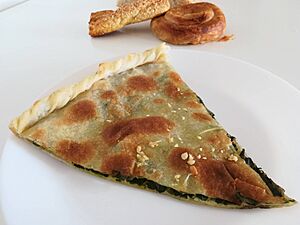Soparnik facts for kids
Soparnik is a tasty pie from Croatia. It usually has a savory filling made from Swiss chard. People also call it soparnjak, zeljanik, or uljenjak.
This special dish comes from the Dalmatian area called Poljica. This region is located between the cities of Split and Omiš. Soparnik was traditionally made in colder months. This was when the chard was older and sweeter.
Soparnik is a simple dish. It uses common ingredients from the area. These include chard, onions, and parsley. They are placed between two thin layers of dough. While most soparnik is savory, some sweet versions exist. These might include nuts, dried fruits, or caramel.
In 2016, the European Commission recognized soparnik. They listed it as an important part of Croatia's national heritage. It also received a special certification for its unique origin.
Contents
History of Soparnik
Many people in the Poljica region believe soparnik is very old. Some even say it was a type of pizza that the Romans brought to Italy. For a long time, it was known as "poor man's food." It was also a popular dish during Lent, a time when people might eat simpler meals.
Today, soparnik is a symbol of the region's culture. You can find it sold in markets and restaurants. It is also a popular food at local events and festivals. Since 2005, there has been a special soparnik festival. It takes place in the town of Dugi Rat.
There is also a group called "Udruga ‘Poljički soparnik’". This group works to protect and promote soparnik. The Croatian Ministry of Culture has officially declared soparnik to be intangible cultural heritage of Croatia. This means it is an important tradition to be preserved.
How to Make Soparnik
Making soparnik involves careful steps to get it just right.
Preparing the Filling
First, the chard leaves are washed well with water. They must be dried completely. This stops the thin dough from getting soggy. You can spread the chard out overnight to dry. Sometimes, a little flour is added to help. The tough stems are removed from the chard. Then, the leaves are cut into strips.
Next, chopped onions and parsley are added to the chard. A little olive oil and salt are mixed in. This creates the flavorful filling.
Making the Dough
The dough is simple. It is made from flour, a little salt, some olive oil, and water. You add just enough water until the dough is right. The dough is then divided into two equal parts. Each part is left to rest for a short time.
Assembling and Baking
One part of the dough is rolled out very thin. It should be a large circle, about 2 to 3 millimeters thick. This is done on a board dusted with flour. The chard filling is spread evenly over this dough layer. Make sure to leave a small edge around the circle.
The second part of the dough is rolled out the same way. This will be the top layer of the pie. It is carefully wrapped around a rolling pin. Then, it is unrolled onto the pie, covering the filling. The edges of the top and bottom dough layers are joined together. They are rolled inward to form a rim.
Traditionally, soparnik is baked on a hot hearth called a komin. It is covered directly with hot embers. When the top layer of dough puffs up from the steam, it needs to be poked a few times. The pie bakes for about 15 to 20 minutes. If you are using an oven, bake it at 200°C (about 390°F). It is ready when the filling has boiled and the dough is golden brown.
After baking, the soparnik is taken out. Any embers are brushed off. It is then flipped over. Once it cools, olive oil is spread on top. Finally, finely chopped garlic is sprinkled over it. Soparnik is usually cut into diamond-shaped pieces for serving.


